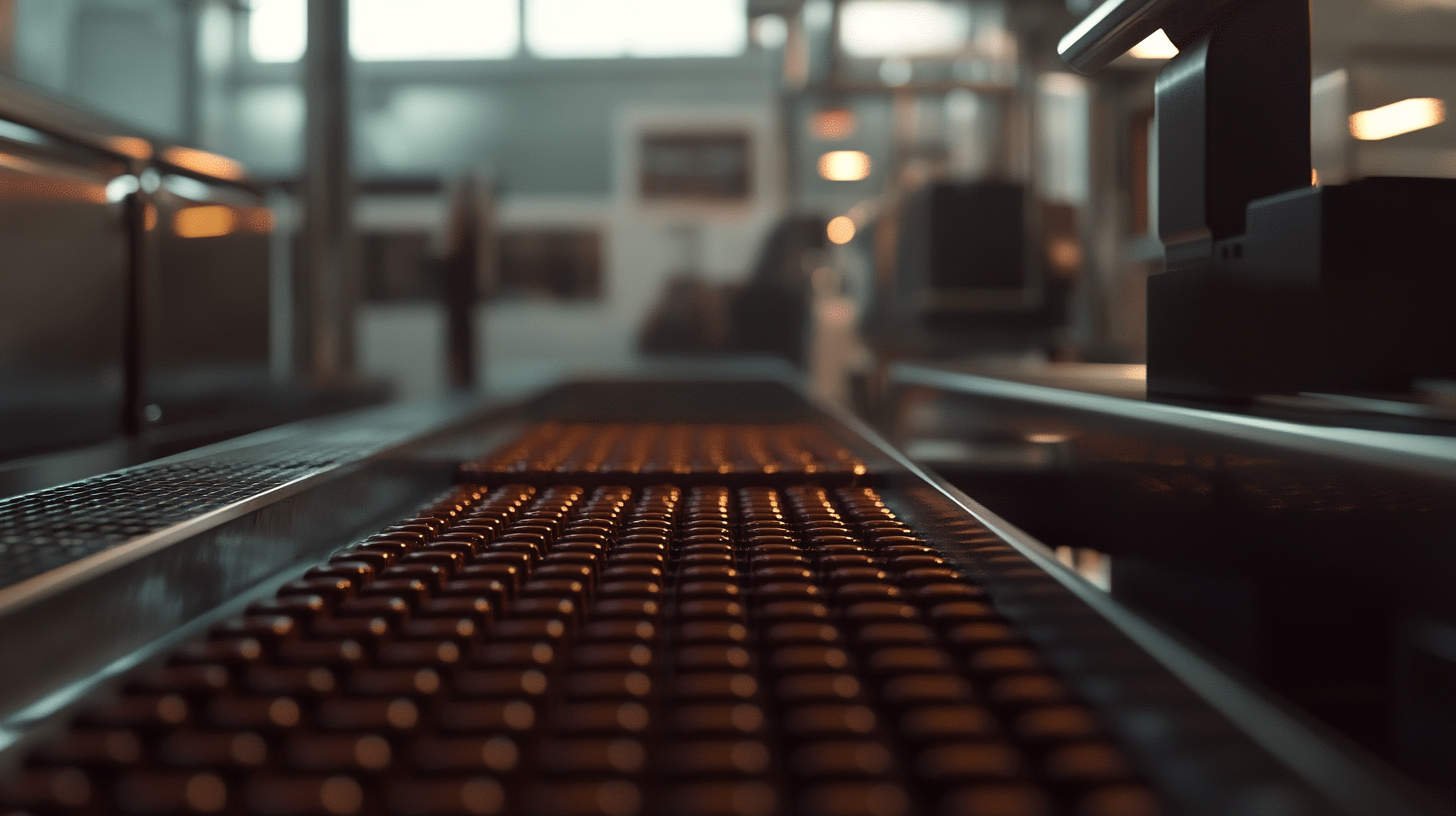Challenges Associated with Chocolate Depositing Equipment
The chocolate market is growing wider worldwide, driven by increasing consumer demand for innovation and high-quality chocolate products. The recent report published by Statista states that the global chocolate market is projected to reach nearly $162.9 billion by 2024 and will trim itself at a compound annual growth rate (CAGR) of 4.2% from 2019 to 2024. This growth offers a tremendous opportunity for manufacturers; however, it brings with itself diverse complexities such as the whole production process, including the chocolate depositing machine. The chocolate depositing machine is one of the most important machines in creating various products.
There also exists a hindrance in the use of chocolate depositing equipment. The greatest impediments that could possibly cause issues in operations include maintenance, flexibility in production, and accommodation of multiple chocolate formulations for production. Another challenging aspect for manufacturers would be an impossibility of achieving convenience and product quality since consumer need continues to vary with time. However, as the industry continues to adapt to these changes, there will be a need to understand the limitations and possibilities of chocolate depositing machines to be competitive in the future emerging markets.

Factors Affecting the Performance of Chocolate Depositing Machines
There are several factors that will focus the performance of chocolate depositing machines. One of the main factors is temperature control in the machine itself. Chocolate is sensitive to temperature variations; thus, it is essential to maintain a uniform temperature throughout the depositing process for the desired texture and sheen. Poor temperature control may cause bloomed chocolate or imperfections in the mold leading ultimately to bad quality of the product. It needs to be mentioned that the other important factor is the type of chocolate used. Different formulations such as dark, milk, or white chocolate may have varying viscosities and melting points and thus can significantly affect the consistency of chocolate flow through the chocolate depositing system. Manufacturers must ensure that their machines are tailored suitably to accommodate the same variations to optimize the deposition process. Special ingredients such as nuts or fruit may also provide challenges to the depositing machinery that requires careful adjustments to maintain even distribution without ruining the chocolate. Finally, however, machine maintenance plays a big role in the performance of chocolate depositing equipment. Regular cleaning and servicing are needed to avoid build-up and optimally allow all the components to function. Failure to maintain the equipment can result in mechanical failures, inconsistent deposits, and therefore increased downtime. Understanding and managing these factors in the sophisticated chocolate manufacture environment is thus pertinent to increased efficiency in production and the quality of products.

Common Technical Issues in Chocolate Depositing Equipment
Such a broad range of challenges have already surfaced concerning the respective area of technology in the chocolate depositing industry, namely the development of aerated or enrobed chocolates. These chocolates are gaining enormous importance internationally. New studies in the industry show that the market is yet expanding for these kinds of specialty products and that manufacturers would be challenged to procure sophisticated equipment to meet such demands of consumer preference changes. Therefore, firms such as Wymbs have now started creating versatile depositing systems that could meet varied requirements, yet with product integrity.
One of the technical issues common among systems used in chocolate depositing is establishing an even temperature control balance. Precise temperature is a major condition for obtaining appropriate texture whereas air incorporation products or other coatings are taken into effect. Changes may lead to some faults like improper condition setting and unpleasant textures and spoilage of materials as well as time loss in production. Reports reveal that there is a recent focus of manufacturers on innovations related to temperature control technologies.
Furthermore, the use of new materials or designs in the recipe for chocolate proves to be yet another barrier. Companies mostly tend to experiment with unconventional raw materials, for instance, spinach, to come up with atypical flavor combinations. However, such ingredients do complicate the process of depositing since they need modification in some equipment settings or will call for new depositing techniques. Therefore, the creativeness that comes into play in adapting existing systems or into new concepts, as demonstrated by SGL Technologies by virtue of its problem-solving approach, knows how to take advantage of very unconventional combinations.
Just as the entire confectionery market faces wider economic pressures, so too do the lollipop and hard candy sectors. However, as stated, the urgent demand for economical depositing solutions remains. Established players like CHOCOTECH, with more than a hundred years of innovation, provide this industry with a strong foundation to tackle such technical challenges head-on and make sure the art of chocolate making keeps on evolving.

Maintenance Challenges in Chocolate Production Lines
The maintenance challenge in chocolate production lines is becoming more complex in the present times with the industry facing shortages of cocoa supply and climbing prices. Reports show a disturbing shortage of cocoa supply of about 11% for 2024, with heightening prices of about 400% in the last one year. Such challenges imply that advanced maintenance techniques are mandatory for maintaining the chocolate depositing machine so that performance and quality remain at par.
With artificial intelligence and big data analytics placed at the very heart of chocolate production maintenance, it then provides distinguishable predictive maintenance where the chocolate manufacturers predict any failure in the system and intervene before the situation actually disrupts the production flow, therefore causing extended downtime. With this, the maintenance system not only enhances operational performance but also confirms sustainability through lesser waste generation and energy consumption; ever more crucial as the industry finds itself being subject to more scrutiny regarding its environmental concerns.
Thus, the apparent cocoa market crisis draws attention to and justifies the need for sustainable sourcing and farming methods. With Indonesia seeing an alarming decline in cocoa production thanks to climate change and various other challenges, chocolate companies are increasingly practicing direct sourcing to strengthen the supply chain and support local farmers. Thus, responsible sourcing of cocoa will help the industry build more resilient production lines and enable maintenance methods to adapt to the changing patterns of cocoa availability.

Impact of Ingredient Variation on Depositing Equipment Efficiency
The chocolate depositing machine works with widely varying efficiencies depending on the composition of the ingredients. Vulnerable parameters would include composition and consistency of rheological properties of chocolate determined by selection and ratios of ingredients like cocoa solids, sugar, and fats, which have been noted to cause unexpected performance mishaps during the depositing process. It has been mentioned in "Chocolate and Confectionery Manufacturing Technology" that a mere 1% variation in cocoa content can cause viscosity change in chocolate, affecting uniformity of deposits and approximately 15% increase in production downtime.
The presence of inclusions like nuts or fruit creates further difficulties in countering these. These additives affect not only flow characteristics but also cause blockages in the depositing nozzle, which affect output efficiency. A survey conducted by the Food Processing Association showed that in most cases, manufacturers cite a 20% drop in production rates when dealing with recipes that have higher inclusion levels. Thus, ingredient control and testing formulations are crucial to the performance of depositors.
In addition, control of temperature would be of utmost importance, since melting point would change depending on formulation manipulations. According to the "Confectionery Engineering Journal," the flow properties of chocolate are enhanced when kept at optimum temperatures, while studies have indicated that depositing accuracy is improved by more than 10% when maintained at a steady temperature within ±2°C. This shows the dire need for the consistency of the ingredients and the proper calibration of depositing machinery so that the variations do not cause the inefficiency or lessen the quality of the final product.
Future Trends in Chocolate Depositing Technology and Solutions
Chocolate depositing technology has traditionally been advancing, as it promises the confectionery manufacturer many ways to improve and direct Chocolat depositing. One hallmark of this trend is the incorporation of advanced features such as smart technology into depositing machines. With an Internet of Things framework, entry into real-time monitoring and control of the depositing process is possible. With this, the temperature, flow rates, and addition parameters are perfectly manageable, leading to a high degree of consistency in quality and limited wastage.
Another unavoidable trend is moving towards sustainability in the manufacture of chocolate as companies are investing more towards green materials and energy roofing machines. It is just what the growing consumer needs for sustainable products, away from nailing to global initiatives in actual carbon footprint reduction in food production. The very latest in advanced chocolate depositing equipment is now a design-focused energy-efficient use of materials and processes, along with biodegradables-it is indeed a step into a greener industry.
Customization of chocolate in products is another promising trend emerging. Today's consumers are searching for personalization in each sweet and chocolate depositing technology is conveniently evolving to this end. Machines are becoming advanced yet in tays that permit complex patterns or shapes to exist in forms highly appreciated by all consumers. With gourmet and artisan chocolate trends becoming increasingly mainstream, the functionality to customize chocolate offerings easily will soon prove a major forte to manufacturers.